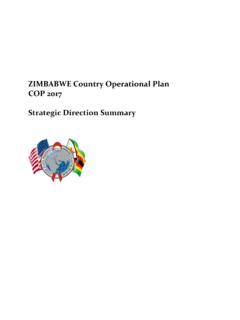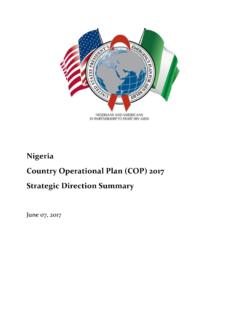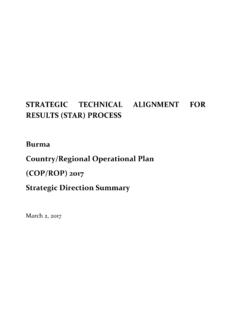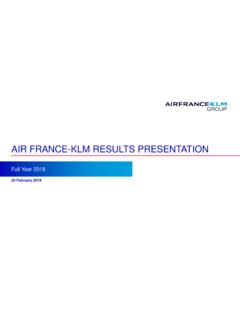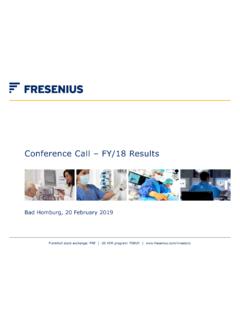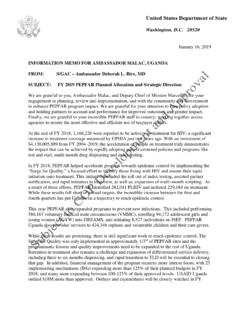Transcription of INFORMATION MEMO FOR AMBASSADOR THOMAS HUSHEK, …
1 January 16, 2019. INFORMATION MEMO FOR AMBASSADOR THOMAS HUSHEK, SOUTH SUDAN. FROM: S/GAC AMBASSADOR Deborah L. Birx, MD. SUBJECT: FY 2019 PEPFAR Planned Allocation and Strategic Direction We are grateful to you, AMBASSADOR Hushek, and your Deputy Chief of Mission, for your engagement in planning, review and implementation, and with the community and Government to enhance PEPFAR program impact. We are grateful for your attention to core policy adoption and holding partners to account and performance for improved outcomes and greater impact. Finally, we are grateful to your incredible PEPFAR staff in country, working together across agencies to ensure the most effective and efficient use of taxpayer dollars.
2 Despite operating in a challenging environment, the PEPFAR/South Sudan Team continues to achieve impressive results and we are grateful to the Team's dedication and the implementing partner's persistence. During FY 2018, the Team identified 10,426 people living with HIV. (PLHIV) - a 25% increase from FY 2017; and started 8,989 new patients on treatment, bringing the total current number of people on treatment to 24,521. Additionally, the Team exceeded their targets for preventing mother to child transmission (PMTCT), and male circumcision (VMMC). By the end of FY 2018, 51,956 pregnant women knew their HIV status, 2,801 HIV- positive pregnant women were started on anti-retroviral treatment (ART); and 814 men received circumcision services under the new VMMC program.
3 The Team also increased the number of orphans and vulnerable children (OVC) reached totaling 1,721. Further, there was a drastic scale up in viral load (VL) coverage from FY 2017 following the addition of a VL machine at the National Public Health Laboratory and the Team's aggressive expansion in the number of sites doing VL sample collection. We commend the South Sudan Team for these achievements. While the PEPFAR/South Sudan program has made great strides over the past fiscal year, successes are not shared evenly across all agencies, implementing partners, or sites. Key programmatic and policy areas require further improvement in order to realize epidemic control. The Team continues to experience significant challenges with retention; particularly among younger age cohorts and men, which has challenged the program's ability to build upon successes it has had in case identification and linkage.
4 More work is also needed in the policy environment to remove barriers for key populations, ensure a quicker transition to TLD as the first line treatment regimen, and increase access to self-testing for harder to reach populations. Lastly, PEPFAR/South Sudan should consider consolidating international partners to reduce high management costs and free-up funding for data driven interventions and program needs. Additional details regarding COP 2019 recommendations can be found in appendices 3 and 4. The President's Emergency Plan for AIDS Relief (PEPFAR) total planning level for South -2- Sudan for the 2019 Country Operational Plan (COP 2019) is $20,000,000, inclusive of all new funding accounts and applied pipeline.
5 If you have questions about the priorities and guidance laid out in this letter, please contact your Chair, Angeli Achrekar, and Program Manager, Elizabeth Baldwin. My office is continually grateful for your Team's work on the PEPFAR program, helping us to move towards controlling the HIV epidemic in South Sudan. APPENDICES: 1. COP 2019 PLANNING LEVEL. 2. COP 2019 BUDGETARY REQUIREMENTS & GUIDANCE. 3. PAST PERFORMANCE. 4. COP 2019 DIRECTIVES. -3- APPENDIX 1: COP 2019 PLANNING LEVEL. Based upon current analysis of spend levels, INFORMATION submitted for the FY 2018 Q4 POART. and performance INFORMATION , the total COP 2019 planning level is estimated to be comprised as follows: Table 1.
6 COP 2019 Budget **. Table 2. Applied Pipeline **. SOUTH SUDAN. COP 2019 Applied Pipeline By Agency Total Applied Pipeline $ 7,803,420. HHS/CDC $ 3,580,146. DOD $ 991,010. USAID $ 3,232,264. **Based on agency reported available pipeline from EOFY. All planning levels are subject to further adjustment, based upon appropriations, further analysis determining the availability of excessive pipeline, and other developments during the course of COP 2018 implementation and the COP 2019 review process. The total spend in the implementation of COP 2019 (FY 2020) may not exceed the total COP 2019 planning level of $20,000,000. -4- APPENDIX 2: COP 2019 BUDGETARY REQUIREMENTS. COP 2019 Earmarks Table 3.
7 COP 2019 Earmarks South Sudan COP 2019 EARMARK REQUIREMENTS. Care and Treatment (C&T) $ 6,342,222. % of base funds allocated to C&T 52%. HKID $ 365,897. Gender Based Violence (GBV) $ - Water $ - Care and Treatment: If there is no adjustment to the COP 2019 new funding level due to an adjustment in applied pipeline, South Sudan's minimum requirement for the care and treatment earmark is reflected in the chart above. Your care and treatment requirement is calculated as the sum of total new FY 2019 funding programmed to the HTXS, HTXD, HVTB, HBHC, PDTX, PDCS budget codes, 30% of the total funding programmed to the MTCT budget code, 80% of the total funding programmed to the HLAB budget code, and 30% of the total funding programmed to the HVCT budget code.
8 This minimum care and treatment earmark has been derived based upon a requirement that your country programs a minimum of 52% of all new FY. 2019 Base Funds to care and treatment of people living with HIV. HKID Requirement: South Sudan's COP 2019 minimum requirement for the HKID budget code is reflected in the chart above. Your COP 2019 HKID requirement is derived based upon the approved COP 2018 HKID level. The COP 2019 planned level of new funds for HKID can be above this amount; however, it cannot fall below it. Gender Based Violence (GBV): South Sudan's COP 2019 minimum requirement for the GBV. earmark is reflected in the chart above. Your GBV earmark requirement is calculated as the total new FY 2019 funding programmed to the GBV cross-cutting code.
9 Your COP 2019 earmark is derived by using the final COP 2018 GBV earmark allocation as a baseline. The COP 2019. planned level of new FY 2019 funds for GBV can be above this amount; however, it cannot fall below it. Water: South Sudan's COP 2019 minimum requirement for the water earmark is reflected in the chart above. Your water earmark requirement is calculated as the total new FY 2019 funding programmed to the water cross-cutting code. Your COP 2019 earmark is derived by using the final COP 2018 water earmark allocation as a baseline. The COP 2019 planned level of new FY. 2019 funds for water can be above this amount; however, it cannot fall below it. -5- COP 2019 Applied Pipeline All agencies in South Sudan should hold a 4 month pipeline at the end of COP 2019.
10 Implementation in order to ensure sufficient funds and prevent disruptions in service delivery in the event of funding delays. Any agency that anticipates ending COP 2018 implementation (end of FY 2019) with a pipeline in excess of 4 months is required to apply this excessive pipeline to COP 2019, decreasing the new funding amount to stay within the planning level. The Applied Pipeline amount of $7,803,420 given by S/GAC as a part of the COP 2019 planning level has been calculated to reflect the projected excessive pipeline as of the beginning of the COP 2019 implementation cycle (FY 2020), and is the minimum amount that South Sudan must apply as pipeline in the COP 2019 submission. The distribution of new base funds and Applied Pipeline was calculated to ensure 3 months of pipeline remains with mechanisms, based upon the financial data submitted for the FY 2018 Q4 Obligation and Outlay and FY 2018 End of Fiscal Year (EOFY) reports.

